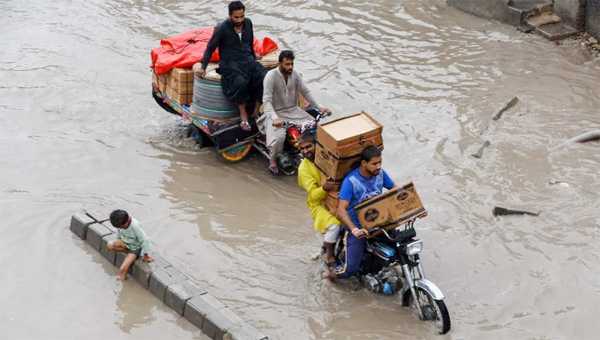News Desk :
Pakistan’s National Disaster Management Authority (NDMA) has reported that at least 195 people have died, and at least 362 people have been injured due to the heavy rains and floods that have battered the country over the past month and a half.
The devastation, which began on July 1, has led to the destruction of 2,293 homes and the loss of 352 livestock, according to the latest NDMA report.
The report also confirmed that seven additional deaths occurred in the 24 hours leading up to August 17.
The fatalities have been primarily due to building collapses, lightning strikes, and drowning in floodwaters. The provinces of Punjab and Khyber Pakhtunkhwa have been the hardest hit, accounting for 139 of the deaths and 322 injuries.
The NDMA has collaborated with the Provincial Disaster Management Authority (PDMA) in Balochistan, which has also experienced severe damage, including flash floods that have ravaged low-lying areas, damaging 22 houses in a single day.
The situation remains critical as the NDMA’s National Emergencies Operation Centre (NEOC) forecasts further heavy rains from the evening of August 18 through August 19. The anticipated downpours could lead to urban flooding in several major cities.
As climate change continues to intensify weather extremes, Pakistan faces growing challenges in managing and recovering from these natural disasters. The ongoing humanitarian crisis demands immediate national and international efforts to aid those affected and to strengthen against future catastrophes.
At least 16 people were killed, 11 injured, and nearly 3,000 were affected as the ongoing monsoon rains, which began on July 1, continued to wreak havoc across various parts of Balochistan on Monday, according to disaster management officials, reports Dawn.
Monsoon rains across the region from June to September offer respite from the summer heat and are crucial to replenishing water supplies and sustaining agriculture, but also lead to weather-related disasters. Experts say climate change is increasing their frequency and severity.
Data from the National Disaster Management Authority (NDMA) shows that from July 1 to August 17, 195 people have been killed and 362 injured across the country due to rain-related incidents, while 2,293 houses have been damaged.
Provincial Disaster Management Authority (PDMA) official Yunus Mengal told Dawn.com that 16 districts of Balochistan were affected by the recent spell of rain while relief was being provided.
“Balochistan has witnessed two dangerous spells of monsoon since July 1, where a total of 16 people have died and 11 have been injured,” Mengal said.
He added that during the spells, 417 houses were damaged due to torrential rains and flood rails — with 124 houses completely collapsing and 293 houses partially damaged. Additionally, he said a total of 2,919 people were affected by the heavy rains.
“Thirty-one kilometers of roads have been affected, six bridges were partially damaged due to stormy rains, while 120 cattle were killed during the rains,” he added.
Balochistan’s provincial government has imposed an emergency in Kalat and Ziarat, while districts such as Awaran, Kachhi, Loralai, Sohbatpur, and Lasbela have been declared calamity-hit.
The highest rainfall was recorded in Kalat with over 48 mm, followed by Usta Muhammad with 34 mm, and Sibbi with 21 mm. Quetta and Khuzdar recorded 10mm of rain each, while Zhob and Chaman recorded 9mm of rain.
Sohbatpur’s Deputy Commissioner Farida Tareen said that a river in Judair overflowed due to the rain, inundating the area and destroying rice fields.
Meanwhile, Balochistan’s National Highway Authority General Manager Agha Inayatullah clarified that all the national highways in north Balochistan were open for all kinds of traffic, with the authority and contractors “working round the clock to rectify damages” of the flood water and keep the roads open.




